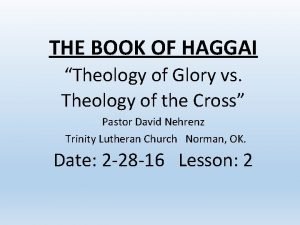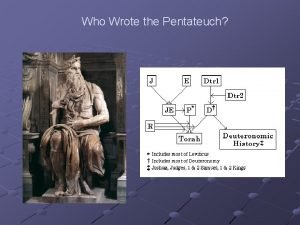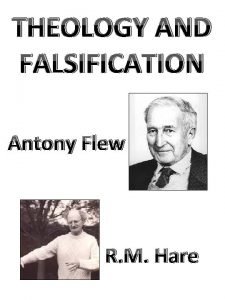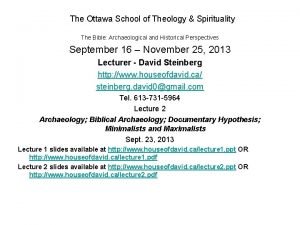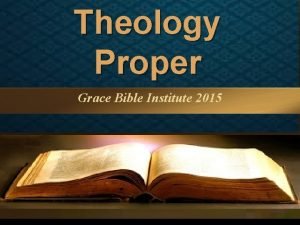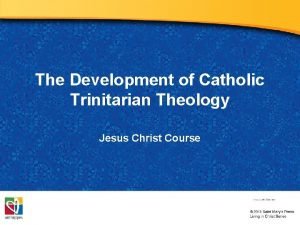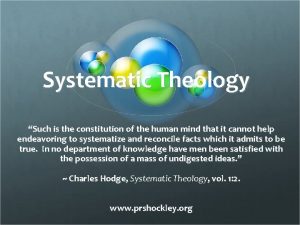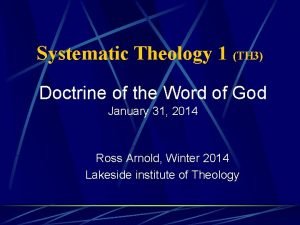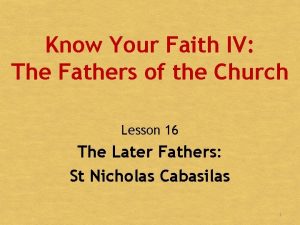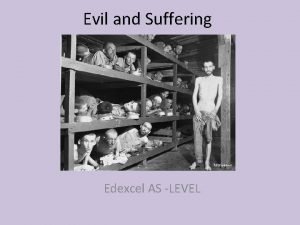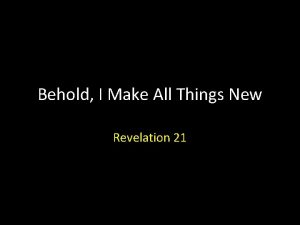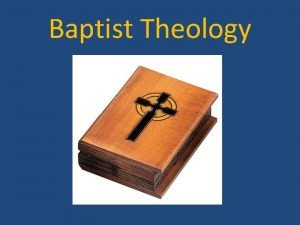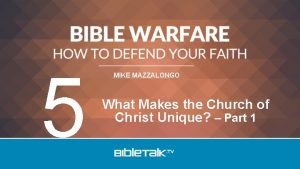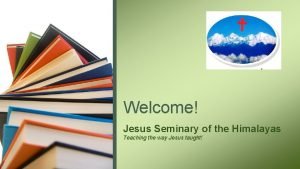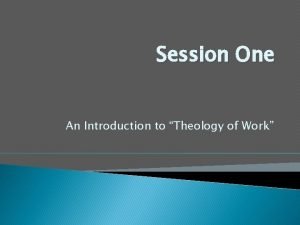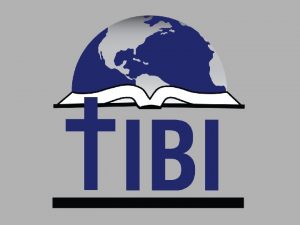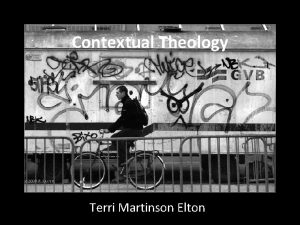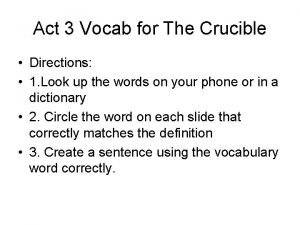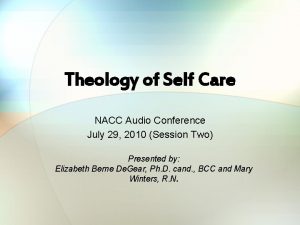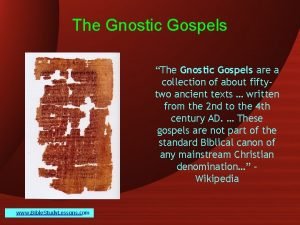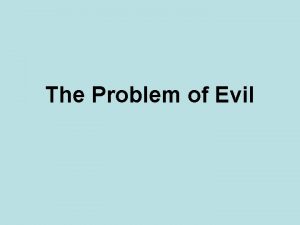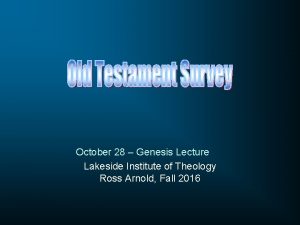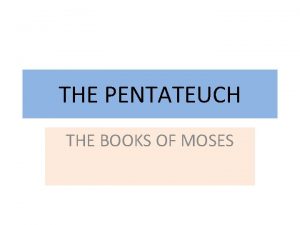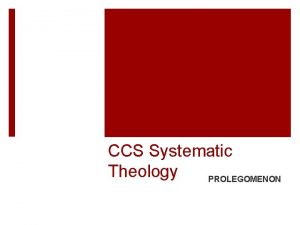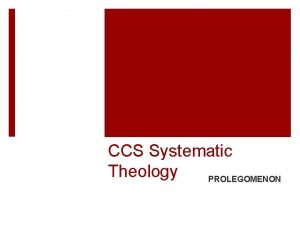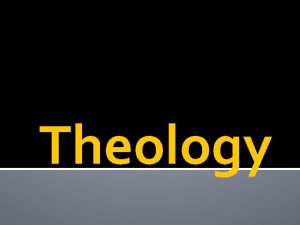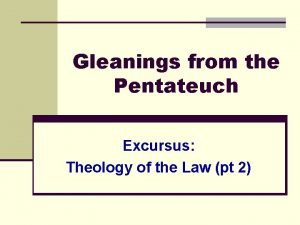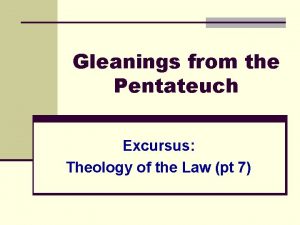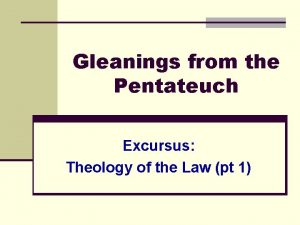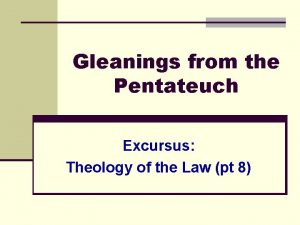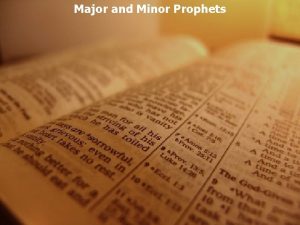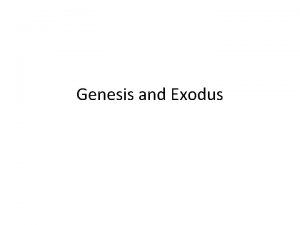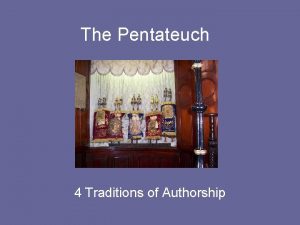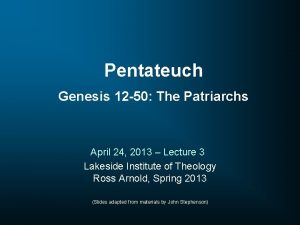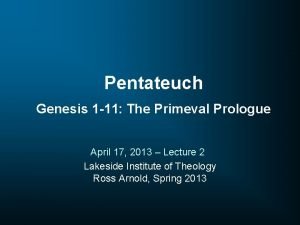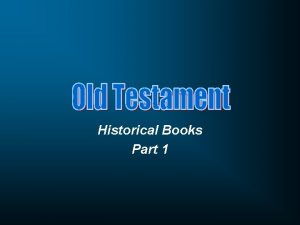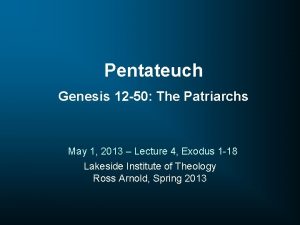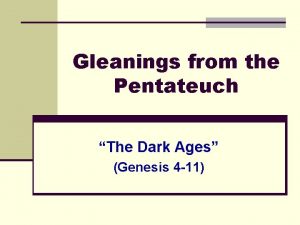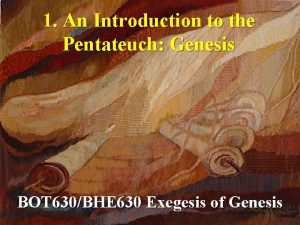The Pentateuch and OT Theology GENESIS I Genesis































- Slides: 31

The Pentateuch and OT Theology

GENESIS

I. Genesis 1 -3 A. Genesis 1 – Creation -God is the creator of and is in control of all things -He created the world with a certain order and in a certain way -ranges from planets and stars to male and female B. Genesis 2 – The Garden -Picture of how humanity is supposed to live -Direct fellowship with God -relational beings (creation of Eve) -ultimate relationship is with God -this is the ‘image’ of 1: 26 C. Genesis 3 – The Fall -Eve falls for lust of flesh, lust of eyes, and pride of life -Satan attacks God’s word and doubts God’s love -Adam does not fulfill his role as the leader -The nature of our falleness is that we refuse to take responsibility D. Genesis 3: 15 – The Gospel -Hebrew word is in the singular (Gal 3: 16) -THE REST OF GENESIS (AND THE OLD TESTAMENT) IS A SEARCHING FOR THE SEED

II. Genesis 4 -11 – Searching for the Seed, Part I A. Genesis 4 – The Nature of Sin -Von Rad- All problems in humanity can be traced back to Gen 2 -3 where Adam and Eve failed to obey. i. Gen 2: 15, ‘to worship and obey’ -disobedience is at the heart of sin ii. Rom 5: 19 - disobedience is the issue -Chapter 4 is frightening because sin is not slowly creeping in but is working at an alarming speed, as seen in Cain’s complete possession by sin. -This, as well as the rest of the OT, is not just history. It is humanity under a microscope.

III. The Abrahamic Covenant (Genesis 12 -24) IV. Isaac and His Sons (Genesis 25 -36) V. Joseph (Genesis 37 -50)

Exodus Deliverance and Law

Outline I. Oppression and Deliverance 1: 1– 15: 21 II. The Journey to Mount Sinai 15: 22– 19: 2 III. The Sinaitic Covenant 19: 3– 24: 18 IV. Instructions for Israel’s Sanctuary 25: 1– 31: 18 V. Apostasy and Intercession 32: 1– 33: 23 VI. The New Tablets 34: 1– 35 VII. Execution of Sanctuary Instructions 35: 1– 40: 38

The Pattern of Redemption • The Exodus is THE Old Testament model of salvation – – – God’s people are in bondage God sends tribulation on the earth as a sign of his judgment God frees his people through his prophet God demands the death of the first-born son God covers his people from his wrath through the blood of the Lamb • Passion Narratives – – – Jesus frees his people from bondage Jesus experiences the tribulation for us Jesus is the anointed one of God, the prophet greater than Moses Jesus is God’s own first-born son Jesus is the Lamb who was slain

The Law • The Wilderness Tabernacle

The Law • How Do We View It As Christians? – Two Relevant Texts • Matt. 5: 17 -20 • Gal. 3: 1 -29

Leviticus

Distinctives of Sacrifice in Israel • Animals Were Not Used for Clairvoyance • Linked to the Covenant Relationship with God • Concept of Holiness of God Was Center

Outline I. III. IV. The Offerings 1: 1– 7: 38 The Priesthood 8: 1– 10: 20 Cleanness and Uncleanness 11: 1– 16: 34 The Holiness Code 17: 1– 27: 34

The Holiness Code • • Sanctity of the Blood Moral Laws Priestly Regulations Worship Calendar Oil, Bread, and Blasphemy Sabbath Year and Jubilee Rewards and Punishments Vows and Tithes

Types of Sacrifices • • • Burnt Offering (Leviticus 1) Cereal Offering (Leviticus 2) Peace Offering (Leviticus 3) Sin Offering (Leviticus 4: 1– 5: 13) Guilt Offering (Leviticus 5: 14– 6: 7)

Issues of Cleanliness • • Food (ch. 11) Childbirth (ch. 12) Skin and Fungus Diseases (chs. 13– 14) Bodily Discharge (ch. 15)

Themes in Leviticus • Law • Sacrifice • Holiness

Numbers

outline I. At Sinai 1: 1– 10: 10 II. From Sinai to Edom 10: 11– 20: 21 III. From Edom to the Jordan 20: 22– 36: 13

Preparation in numbers • Preparing to Leave Mount Sinai • 1: 1– 10: 10 • Preparing to Enter Canaan • 20: 22– 36: 13

Preparation at mount sinai Laws and Instructions Numbers • Organizing the tribes around the tabernacle • Treatment of those who defiled the camp • Importance of dedication and faithfulness to God • Instructions on moving the tabernacle • Instructions on departure • 1– 4 • 5 • 6 • 7– 8 • 9: 1 – 10: 10

Back to the law… • Numbers 10 ends a continuous stream of lawgiving that began in Exodus 20 • The fundamental problem with Israel that is exacerbated in Numbers is that they cannot obey – We already saw this with the grumbling after the crossing of the Red Sea, the golden calf incident in Exodus 34, and the provisions for sinning in Leviticus – Only Caleb and Joshua obey out of all of the first generation of Israel – Num. 14: 24 – Caleb had a different spirit • This problem governs the preparation in Num. 20 Deuternomy 34 and the narrative of the Deuteronomistic history (Joshua-Kings)

DEUTERONOMY

Elements of Hittite Suzerainty Covenant 1. 1. Preamble 2. Historical Prologue 3. Stipulations 4. Provision for Deposit in Temple and Periodic Public Reading 5. List of Gods as Witnesses 6. Curses and Blessings Formula

Deity in the Ancient Near East • Monotheism Israel – Vs. • Polytheism All other nations

Outline I. I. Prologue 1: 1– 5 II. The Great King’s Faithfulness 1: 6– 4: 43 III. The Covenant Way of Life 4: 44– 26: 19 IV. Covenant Sanctions 27: 1– 31: 30 V. Appendixes 32: 1– 34: 12

Introduction – chs. 1 -3 A. A. Deuteronomy = Second Law, but really is second giving of the Law 1. preparation for the second generation of Israel to enter the land B. Summary of Exodus through Numbers 1. Wanderings – 1 -2 2. defeat of kings Sihon and Og – 2 -3

C. Theological Impact 1. quotations of Abrahamic covenant a. 1: 8 – Go and take the land b. 1: 10 – multiplied more than the stars of heaven c. Genesis 15 Deuteronomy 1 = Deut is completion of Pentateuch 2. Reminder of the past a. the Exodus and God’s provision (1: 27 -32; 2: 7) b. Israel’s failure (1: 26, 34 ff. ; 1: 34 & 2: 16 (not entering the land)) c. not going up = Mt. Sinai = reason for law Kingdom with priests, not of priests d. 1 Cor. 10: 1 -22; Hebrews 3: 19

A Vision of God’s Kingdom – chs. 4 -11 A. -4: 9 – Remember what God has done lest you turn away 1. Reiteration of 1 st two commandments B. Chapter 5 – Reiterates 10 Commandments C. Chapter 6 – Shema – Our response to God is obedience and instruction D. Chapters 7 -9 – Israel is God’s chosen people not because of their own merit but because of his grace (7: 6 -11, esp. v. 11; 9: 4 -12) E. Chapter 10 – What does God require? (esp. 10: 12 -22) F. Chapter 11 – LOVE GOD B/C OF WHAT HE’S DONE FOR US (esp. 11: 1 -9, 31 -32)

Laws, Stipulations, and Succession – chs. 12 -30 A. Laws of Israel – Chapters 12 -27 1. Given b/c Israel did not go up the mountain or into the land B. Blessings and Curses – Chapters 28 -30 1. 30: 17 -18 – Israel is going to fail Know this from Joshua and Judges (rest of canon) C. Joshua’s Succession – Chapters 31 -34 A. We are waiting on a prophet greater than Moses (Deut. 18), but evidently Joshua isn’t it – even though he’s pictured as a new Moses

Christological Impact A. Christ succeeds where Israel fails (Matt 4 – Deut 8: 3, 6: 16, 6: 13) B. Christ takes the curse for us (Deut. 21: 22 -23 – cursed on a tree Galatians 3: 10 -14) C. Blessings and Curses 1. We find all our spiritual blessings in Christ (Eph 1: 3 -14; 2: 4 -7) D. Christ is greater than Moses 1. Ch. 18 – A prophet like Moses a. Matt 17 – Mt. of Transfiguration – Jesus is greater than Elijah and Moses 2. Ch. 34 – Seam, prophet greater than Moses (Joshua 1, Psalm 1, Mal 3) a. Hebrews 3
 Theology of glory vs theology of the cross
Theology of glory vs theology of the cross Who wrote the pentateuch
Who wrote the pentateuch Basil mitchell parable of the partisan
Basil mitchell parable of the partisan Seattle university school of theology and ministry
Seattle university school of theology and ministry Antony flew theology and falsification
Antony flew theology and falsification Ottawa school of theology and spirituality
Ottawa school of theology and spirituality Define theology proper
Define theology proper Proper_grace
Proper_grace The development of catholic trinitarian theology
The development of catholic trinitarian theology Define systematic theology
Define systematic theology Theology proper lecture notes
Theology proper lecture notes What is theology
What is theology Palamite theology
Palamite theology Mackies inconsistent triad
Mackies inconsistent triad Revelation 21:9-10
Revelation 21:9-10 R alan culpepper
R alan culpepper Arminian theology
Arminian theology Mike mazzalongo church of christ
Mike mazzalongo church of christ 5 pillars of reformed theology
5 pillars of reformed theology Himalayan graduate school of theology
Himalayan graduate school of theology Symbols in the crucible
Symbols in the crucible Theology of work
Theology of work Practical theology mpt
Practical theology mpt Praxis model of contextual theology
Praxis model of contextual theology Theology definition in the crucible
Theology definition in the crucible Theology of self care
Theology of self care Gnostic gospels summary
Gnostic gospels summary New creation theology
New creation theology Theology of missions
Theology of missions Process theology
Process theology Lakeside institute of theology
Lakeside institute of theology Mono theology
Mono theology
